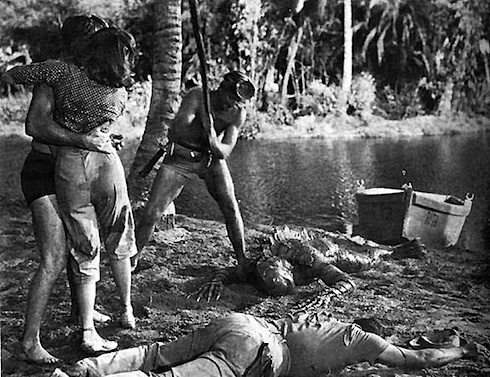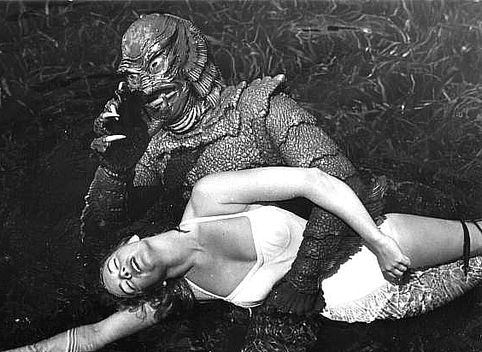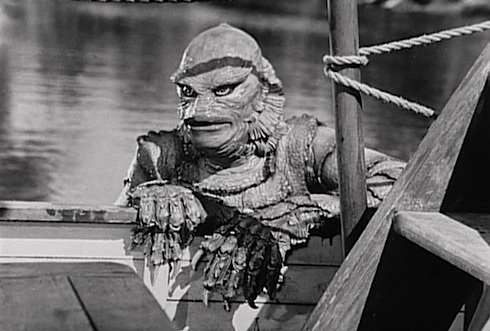Discussing the black and white monsters movies we all loved as children conjures up another kind of creature; the creature from the lagoon of nostalgia. Throughout my various fresh looks at these beloved and indisputably influential and important films, I keep finding places where the films might not work as character pieces or as compelling, well constructed plots. This is usually okay, since most monster movies are designed to have you marvel at the monster and hopefully be put into suspense as you imagine yourself as the characters whom the monster is coming for. This is why the characters in these kinds of movies are often flat. We’re not supposed to like them, but instead, be able to graft our own complexities and hang-ups on to them.
Creature from the Black Lagoon was the first movie filmed in 3-D, and just like many of 3-D spectacles of today, its characters are a little flat. But unlike James Cameron’s Avatar, it’s a total treat to watch it on the small screen, as even when flattened, this 3-D flick is visually gorgeous.
The story involves an ichthyologist named David, his girlfriend Kay, an older archaeologist named Dr. Maia, and a guy who is essentially their wallet named Mark. The movie opens in the Amazon, where Dr. Maia discovers a fossilized hand which seems to date back to the Devonian period. Because the claw/hand seems to have come from an amphibious creature, Maia decides to recruit his old buddy David and fellow cohorts from the nearby marine biology institute. Together they all set on an expedition to get the rest of the skeleton. This scene presents perhaps the only thematic element of the film. David is interested in finding the complete skeleton, because discovering how a humanoid creature breathed underwater is not only inherently scientifically valuable, but also could be valuable in figuring out how to help humans breathe on other planets! Mark on the other hand just sees dollars. More dollars for his industry, which you have to guess is some kind of supermarket version of a museum. So David is the nice science loving guy, and Mark is the cold hard business man.
After not being able to locate the complete skeleton, our crew takes a trip down the Amazon to look for fossils that might be underwater. This isn’t explained well, but whatever, you’ve got to get these guys in the water somehow, right? If at this point you keep asking yourself, “Hey wait, who’s that guy again?” or “Why are there so many extra people on the ship?” then I have an answer for you: this creature ain’t gonna feed itself. It needs some people to kill! The classic Star Trek learned its lessons well from Creature. To be fair, the Gill-man doesn’t actually eat these guys, but rather kills them with his awesome hands. The Gill-man’s a strangler, and a fairly effective one at that. Thought it does baffle me that for a guy who seems to possess super-strength, and who can breathe on both land and water, why doesn’t he just drag these guys into the water and casually hold their head under the surface? Hell, you wouldn’t even have to get out of the water half the time. These guys are coming to you anyway!
As guys get strangled, and Kay continues to change outfits every five minutes or so, David and Mark start to get really into what to do about the Gill-man. My favorite part might be when David mockingly refers to Mark as a “big-game hunter” as if it’s so progressive. With all of its grounding in paleontology and speculation about evolution, Creature from the Black Lagoon is firmly a science fiction movie. And it’s nice that it sort of high-fives with the science fiction sensibility of not just asking “what if?” but also using the manifestation of that question to make a little social commentary about how we ought to treat all life forms.
At one point, the gang has the Gill-man in a bamboo cage, but you get the sense he’s just kind of screwing with them. Eventually after a big creature and mouse game, the Gill-man has the boat trapped with a makeshift dam that he’s constructed out of a bunch of sticks. With all the random “other guys” dead, it’s up to David and Mark to take care of business. In a desperate attempt to capture the creature, Mark is killed. It’s notable that people die constantly in this movie, and no one seems really fazed by it, nor do they talk about what they’re doing with the bodies. When Dr. Maia’s two associates are found dead at the beginning of the voyage, the next scene just shows our heroes digging for some fossils, not digging graves. When Mark dies toward the end, this kind of resonates a bit, but he’s such an asshole that, for the most part, sympathy isn’t really on our minds.

In the end, the Gill-man manages to grab Kay and whisk her away to his underwater lair, where he just sort of props her up on a rock and looks at her. I suppose we could see the Gill-man as a centuries old virgin, he just can’t figure out how to express his urges, so he puts Kay on pedestal, and chokes everyone else. Despite this, I still like him, and when he is shot repeatly, and stumbles into the water at the end, I found myself just as sad as I was when the child version of me endured this brutal scene. (Thankfully, David makes the shooting stop, giving you a little hope that the Gill-man isn’t dead forever.)
If movies should be judged exclusively on their aesthetics and praised by the creative way in which they utilize the medium of cinema, then Creature from the Black Lagoon could be considered one of the best movies of all time. The shots are clean, impressive, and occasionally artful. When the camera goes with the humans or the creature into the depths of the lagoon, you never feel like you’re watching something filmed inside of a Hollywood swimming pool. Nice little touches are used to accomplish this, like having a harpoon gun acquire some seaweed after being underwater for awhile. The initial scene where the creature makes a grab for Kay’s leg while she’s swimming is a particularly neat set of images. Kay is in the background, spinning around in a kind of synchronized swimmer loop, while the Gill-man is in the foreground zigzagging more jerkily, but somehow, not ungracefully. Considering that a good portion of this movie takes place underwater, and that it was made in 1954, the whole thing still looks completely convincing. (And as much love as I have for Thunderball’s underwater sequences, Creature—made over a decade earlier—is easily better shot and less hokey.)

Both the score and the sound effects are also tops. Where something like Dracula might not need a score, Creature simply wouldn’t be a complete film without it. The bombastic blaring brass hits us in the face at nearly the very start of the film when we first see the Gill-man’s webbed-claws pop up out of the water. I remember associating that particularly brassy fanfare not with the image of the entire Gill-man, but instead, just with his hand. Which I think is the correct association, since the music mostly accompanies a shot where his hand is sticking out of a lagoon, or shoving itself through a porthole. The Gill-man himself doesn’t need to make any noise at all, because he’s got a totally sick theme song.
The characters are flat, and generic, with some of them only there to get killed. This makes the plot a little lumbering at times, because you start to wish you could just get down to the few main people the Gill-man isn’t going to kill. But, by the end of the film, you’ll likely not remember any of these frustrations, because everything was just too much fun to look at. It may be a shallow lagoon, but it’s pretty.
To read about the ways contemporary author Jim Shepard reimagined this story as a piece of literary short-fiction, click here, and here.
Ryan Britt is the staff writer for Tor.com.











The underwater photography in this really is beautiful….But then I seemed to have been obsessed with underwater nature shows since being a little kid.
@@@@@ Irene
I used to pretend I was the Gill-man in my pool as a little kid.
This was always one of my favorite movies as a kid, and I was pleasantly surprised with how much better it held up than other mosnter movies upon my re-watch a couple of years ago. I also found several shots and elements of the music that reminded me of Jaws, which I don’t know if Spielberg or Williams ever acknowledged.
It only just occurred to me how much this movie “borrowed” from King Kong. Still, it is very well done and one of the better examples of mid-50s monster movies. Is it just my wonky memory or doesn’t this also end with a huge question mark superimposed over the footage of the possibly lifeless gill-man sinking to the bottom? That also give us a little hope that he survived. But given the less than fortunate sequel, it might have been better if he hadn’t.
This is my favorite of the classic Universal Monsters. I had the good fortune of, though being born in the early 60s, seeing this film projected in a theater in 3-D in the 1980’s. The 3-D looked great and Jack Arnold sure knew how to use it versus abuse it. I have the legacy collection DVD and while the sequels certainly dropped in quality the second one is still a bit of fun to watch.
They keep talking about a remake but that would be a crime in my opinion.
@@.-@ I like what it borrows from Kong. I sort of remember that question mark too, but maybe you’ve just planted it in my mind!
@5 A remake would be terrible. I’m sure of it. Even if it were tasteful and done by all the right people, it would still make me feel funny.
Parts of this were filmed at Wakula Springs, south of Tallahassee, Florida. The springs are known for the crystal clear water and uncharted underwater caves. Some of the Tarzan movies were filmer there also.